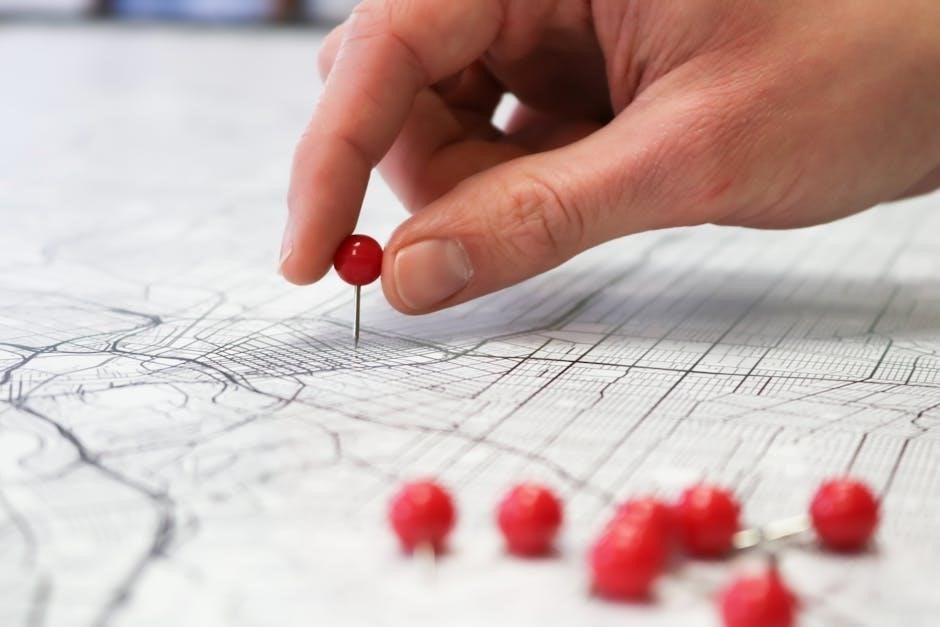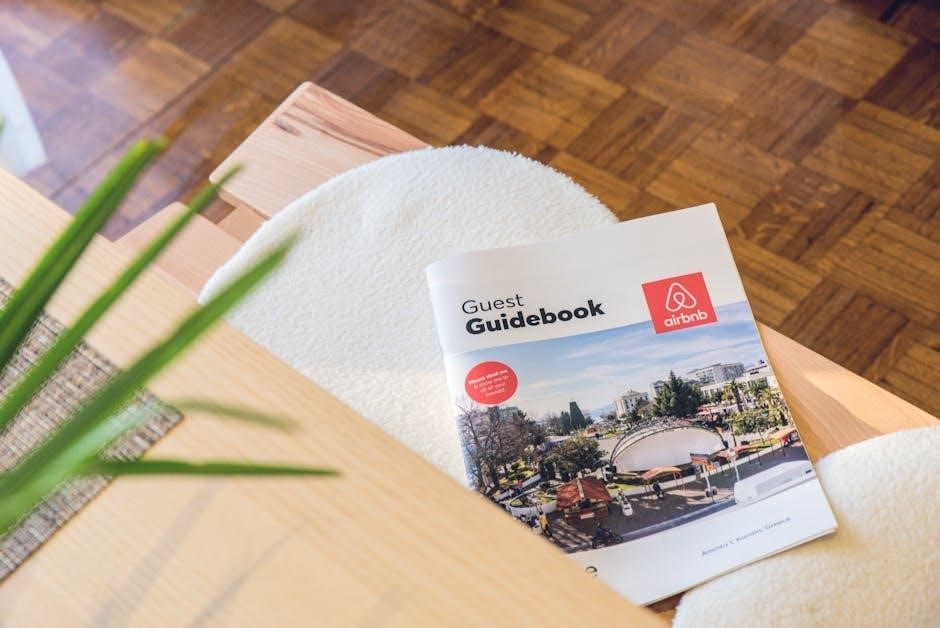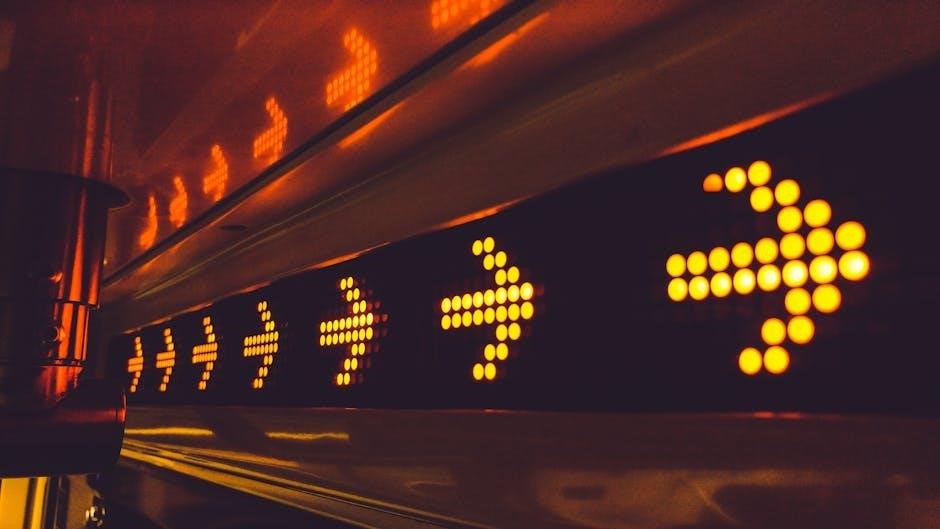Discover how IPTV transforms your viewing experience with personalized channel listings, EPG, and on-demand content․ This guide helps you navigate and maximize your IPTV service effectively․
1․1 What is IPTV?
IPTV (Internet Protocol Television) delivers television content over the internet, offering live TV, on-demand movies, and series․ Unlike traditional cable or satellite TV, IPTV streams content digitally, providing flexibility and accessibility across various devices․ It enables personalized viewing experiences with features like catch-up TV and video-on-demand, making it a modern alternative to conventional broadcasting․
1․2 Importance of a TV Guide for IPTV
A TV guide is essential for IPTV, enabling users to navigate channels, programs, and schedules effortlessly․ It provides detailed listings, program descriptions, and airing times, enhancing the viewing experience․ With features like EPG, users can plan their watching schedule, discover new content, and access on-demand services․ A well-organized TV guide simplifies content discovery, making IPTV more enjoyable and user-friendly across multiple devices․
Setting Up Your IPTV Service
Setting up IPTV is straightforward with the right provider and device․ Ensure a stable internet connection, follow installation guides, and configure settings for a seamless viewing experience․
2․1 Choosing the Right IPTV Provider
Selecting a reliable IPTV provider is crucial for a seamless viewing experience․ Ensure the provider offers stable service, a robust channel lineup, and supports multiple devices․ Check for features like EPG, VoD, and parental controls․ Read reviews and compare packages to find the best fit for your needs, ensuring access to your preferred content and regional channels․
2․2 Installing IPTV on Your Device
Installing IPTV on your device is straightforward․ Download the IPTV app from the official store or provider’s website․ Enter the login credentials or M3U URL provided by your IPTV service․ Ensure your device supports the app, whether it’s a smartphone, smart TV, or streaming device․ Follow on-screen instructions to complete the setup and access your channel lineup and EPG for a seamless viewing experience․
Understanding IPTV Channel Listings
IPTV channel listings are essential for a seamless viewing experience․ Learn to manage and organize your channels effectively, ensuring access to your favorite shows and discovering new content effortlessly with your IPTV TV Guide․
3․1 How to Manage Your Channel List
Organize your IPTV channels by categories like movies, sports, or news for easy navigation; Use the EPG to schedule viewing and update your list regularly․ Remove unused channels to streamline your selection․ Personalize your lineup by adding favorites and setting reminders for upcoming shows․ This ensures a seamless and tailored viewing experience tailored to your preferences․
3․2 Organizing Channels for Easy Access
Group channels into categories like movies, sports, or news for quick access․ Use favorites lists to prioritize popular channels․ Sort alphabetically or by genre to simplify navigation․ Customize your IPTV lineup to display only subscribed or high-definition channels․ This streamlined approach ensures you find content effortlessly, enhancing your overall viewing experience with a well-organized and user-friendly interface․
Electronic Program Guide (EPG)
An EPG provides detailed TV schedules, program descriptions, and airing times․ It helps users discover content, set reminders, and access on-demand services, enhancing the viewing experience․
4․1 What is an EPG?
An Electronic Program Guide (EPG) is a digital menu that displays TV listings, program details, and airing times․ It allows users to browse channels, set reminders, and access on-demand content․ EPGs are essential for IPTV services, providing viewers with a user-friendly interface to navigate and plan their viewing schedules efficiently․ This feature enhances the overall entertainment experience by making content discovery seamless and intuitive․
4․2 How to Use EPG for Better Viewing
Maximize your IPTV experience by utilizing the EPG effectively․ Browse through channel listings, set reminders for upcoming shows, and filter content by genre or time․ The EPG also allows you to access detailed program descriptions, enabling informed viewing decisions․ By leveraging these features, you can streamline your entertainment experience and never miss your favorite programs or live events․
Enhancing Your Viewing Experience
Personalize your IPTV experience with tailored channel lineups, VoD integration, and catch-up TV․ Multi-device synchronization ensures seamless access, making entertainment more flexible and enjoyable across all platforms․
5․1 Personalizing Your TV Guide
Personalizing your IPTV TV guide enhances your viewing experience by allowing you to create a tailored channel lineup․ Use features like favorites and reminders to prioritize shows and events․ The EPG helps you navigate schedules effortlessly, while customization options ensure you only see content that interests you, making your entertainment experience more enjoyable and convenient across all devices․
5․2 Using Catch-Up TV and VoD Services
Catch-Up TV and Video on Demand (VoD) services offer unparalleled flexibility, allowing you to watch missed episodes or movies anytime․ VoD provides instant access to a vast library of content, while Catch-Up TV enables re-watching of recently aired shows․ These features complement live TV, ensuring you never miss your favorite programs and enhancing your IPTV experience with convenience and variety across multiple devices․
IPTV TV Guide Features
IPTV TV guides offer advanced features like time-shifted viewing, recording options, and multi-device synchronization․ These tools enhance flexibility, allowing seamless access to content across various devices and platforms․
6․1 Time-Shifted TV and Recording Options
Time-shifted TV allows viewers to pause, rewind, and replay live broadcasts, offering greater flexibility․ Recording options enable users to save favorite shows for later viewing․ These features enhance personalization, ensuring you never miss your preferred content․ With IPTV, you can easily manage and access recorded programs, making your entertainment experience more convenient and enjoyable anytime, anywhere․
6․2 Multi-Device Support and Synchronization
IPTV offers seamless multi-device support, allowing access on smartphones, tablets, smart TVs, and streaming devices․ Synchronization ensures a consistent viewing experience across all devices․ Start watching on one device and resume on another effortlessly․ This feature enhances flexibility, enabling users to enjoy their favorite content anytime, anywhere, with a unified entertainment experience․
Popular IPTV Service Providers
Discover leading IPTV providers in the USA and UK, offering affordable, flexible services with VoD, Catch-up TV, and live sports, perfect for modern viewers․
7․1 Best IPTV Services in the USA
Top IPTV providers in the USA offer affordable, flexible services with VoD, live sports, and EPG․ They provide access to thousands of channels, ensuring a seamless viewing experience across multiple devices․ These services are ideal for sports fans and movie enthusiasts, offering high-quality streams and user-friendly interfaces․ They cater to diverse preferences, making them a popular choice for modern entertainment seekers․
7․2 Top IPTV Providers in the UK
In the UK, IPTV has gained popularity as a cost-effective alternative to traditional services․ Top providers offer VoD, live sports, and EPG, ensuring a flexible viewing experience․ These services cater to diverse audiences, providing access to a wide range of channels and on-demand content․ They are known for their user-friendly interfaces and high-quality streams, making them a preferred choice for UK viewers seeking affordable entertainment solutions․
Local TV Listings and Schedules
Find local TV listings and schedules easily with IPTV․ Check what’s on in your area, including channels in Canada and the US, and stay updated on local programming․
8․1 Finding Local Channels in Your Area
With IPTV, easily discover local channels in your region․ Check detailed listings for Canada and the US, ensuring you never miss local programming․ Use the EPG to browse schedules and manage your channel lineup for a seamless viewing experience tailored to your location․
8․2 Checking TV Schedules in Canada and the US
Effortlessly check TV schedules in Canada and the US with your IPTV TV guide․ Access detailed listings for local and national channels, ensuring you stay updated on your favorite shows․ Whether it’s broadcast, cable, or satellite, IPTV provides real-time updates, making it easy to plan your viewing experience across both countries․
Advanced IPTV Features
Explore advanced IPTV features like Video on Demand (VoD) and Catch-Up TV․ Enjoy time-shifted viewing and parental controls for a tailored entertainment experience․
9․1 Video on Demand (VoD) Integration
Video on Demand (VoD) integration allows users to access a vast library of movies, series, and shows anytime․ This feature enhances flexibility, enabling viewers to watch content at their convenience without adhering to fixed schedules․ VoD services are seamlessly integrated into IPTV platforms, providing an enriched entertainment experience with diverse on-demand options․
9․2 Parental Controls and Content Restrictions
Parental controls enable users to restrict access to content based on ratings or maturity levels, ensuring a safe viewing environment for children․ These features allow parents to manage what their kids watch, aligning with their values․ Content restrictions can be easily applied across multiple devices, providing consistent protection and peace of mind for families using IPTV services․
IPTV TV Guide for Multiple Devices
Enjoy seamless IPTV access across smartphones, smart TVs, and streaming devices․ Multi-device support ensures synchronized viewing experiences, allowing you to watch your favorite content anywhere, anytime effortlessly․
10․1 Watching IPTV on Smartphones
Stream live TV and on-demand content directly on your smartphone with IPTV․ Download dedicated apps, sync your channel list, and enjoy portable entertainment․ Use the EPG to check schedules and set reminders․ Ensure a stable internet connection for high-quality streaming․ This convenience allows you to watch your favorite shows anywhere, making IPTV a versatile option for modern viewers․
10․2 Accessing IPTV on Smart TVs and Streaming Devices
Enhance your viewing experience by accessing IPTV on smart TVs and streaming devices․ Install IPTV apps like TiviMate or IPTV Smarters, sync your channel list, and enjoy seamless entertainment․ Multi-device support ensures a unified experience across all platforms․ Use the EPG to browse schedules and access VoD content effortlessly, making IPTV a perfect choice for modern streaming needs․
Customizing Your IPTV Experience
Personalize your IPTV experience by creating a tailored channel lineup and setting up favorites and reminders․ This ensures easy access to preferred content and enhances overall navigation․
11․1 Creating a Personalized Channel Lineup
Customize your IPTV experience by organizing channels into a personalized lineup․ Prioritize favorite channels, group them by genre, and easily access preferred content․ This setup enhances navigation and ensures a seamless viewing experience tailored to your preferences․
11․2 Setting Up Favorites and Reminders
Enhance your IPTV experience by setting up favorites and reminders․ Mark preferred channels and shows for quick access, and receive alerts for upcoming programs․ This feature ensures you never miss your favorite content, making your viewing experience more convenient and enjoyable․ Use the EPG to schedule reminders and organize your entertainment seamlessly․
Troubleshooting IPTV TV Guide Issues
Resolve common IPTV TV Guide problems like channel unavailability or EPG inaccuracies․ Update your channel list, restart the app, or check your internet connection for smooth viewing․
12․1 Common Problems and Solutions
Common IPTV issues include channel unavailability, EPG inaccuracies, and buffering․ Solutions involve checking internet connectivity, updating channel lists, and restarting devices․ Ensure stable internet for smooth streaming and refresh EPG regularly for accurate schedules․ Clear app cache or reinstall if issues persist․ Contact your provider for unresolved problems to maintain uninterrupted entertainment․
12․2 Updating Your Channel List and EPG
Regularly updating your IPTV channel list and EPG ensures access to the latest content and schedules․ Use automatic updates or manually refresh via your provider’s portal․ Synchronize your EPG to maintain accurate program listings․ This process helps resolve missing channels, outdated schedules, and ensures a seamless viewing experience with the most current entertainment options available․
The Future of IPTV TV Guides
The future of IPTV TV guides lies in AI-driven personalization, enhanced multi-device synchronization, and advanced EPG features, offering users a smarter, more seamless entertainment experience․
13․1 Emerging Trends in IPTV Technology
Emerging trends in IPTV technology include AI-driven personalization, enhanced multi-device synchronization, and 4K/8K streaming capabilities․ Cloud-based solutions and interactive features like time-shifted viewing are also gaining traction, improving user experience and accessibility․ These advancements are reshaping how content is delivered and consumed, offering viewers more control and flexibility in their entertainment options․
13․2 How AI is Changing TV Guides
AI is revolutionizing TV guides by enabling personalized recommendations and smarter EPGs․ It learns viewing habits to suggest content, enhancing discovery and satisfaction․ AI also powers real-time updates and seamless integration with IPTV services, ensuring guides stay relevant and user-friendly․ This technology is making TV guides more intuitive and dynamic, shaping the future of entertainment navigation․
IPTV TV Guide for Sports and Live Events
Experience live sports and events with IPTV, offering real-time updates and exclusive coverage․ The TV guide ensures you never miss your favorite games or live broadcasts․
14․1 Watching Live Sports with IPTV
IPTV is a top choice for sports enthusiasts, offering extensive live event coverage․ With IPTV, you can stream sports in HD, access real-time scores, and enjoy uninterrupted broadcasts․ The TV guide helps you track schedules, ensuring you never miss a match or event․ Whether it’s football, basketball, or tennis, IPTV delivers a seamless sports viewing experience tailored to your preferences․
14․2 Never Miss Your Favorite Live Events
IPTV ensures you never miss live events with its robust EPG and reminder features․ Set alerts for upcoming games, concerts, or shows and sync across devices․ The TV guide provides real-time updates, while multi-device support lets you switch seamlessly․ With IPTV, you can enjoy uninterrupted access to live events, ensuring your favorite moments are always within reach, no matter where you are․
IPTV TV Guide for Movies and Series
IPTV TV Guide offers extensive libraries of movies and series through VoD and Catch-Up TV․ Easily browse and discover new content, organize favorites, and enjoy personalized recommendations for the best viewing experience․
15․1 Browsing On-Demand Content
IPTV TV Guide simplifies browsing on-demand content with intuitive interfaces․ Users can explore movies, series, and shows by genre, ratings, or recommendations, ensuring effortless discovery of new favorites․
With VoD integration, viewers enjoy instant access to vast libraries, while Catch-Up TV allows re-watching missed episodes․ This feature-rich platform enhances entertainment flexibility and personalization for a seamless viewing experience․
15․2 Finding the Best Movies and Shows
The IPTV TV Guide offers an extensive library of on-demand content, making it easy to discover top-rated movies and shows․ Users can filter by genre, ratings, or popularity to find trending titles or hidden gems․ Personalized recommendations further enhance the experience, ensuring viewers never miss out on compelling entertainment tailored to their preferences․
In conclusion, your IPTV TV Guide is your gateway to endless entertainment possibilities․ With personalized channel listings, EPG, and on-demand content, it ensures a seamless and enjoyable viewing experience․
16․1 Maximizing Your IPTV TV Guide Experience
To maximize your IPTV TV Guide experience, leverage features like EPG for scheduling, organize channels for easy access, and utilize multi-device support․ Personalize your lineup with favorites and reminders, and explore VoD for on-demand content․ Stay updated with the latest trends, such as AI-driven recommendations, to enhance your viewing journey․ This guide ensures you make the most of your IPTV service seamlessly․
































































